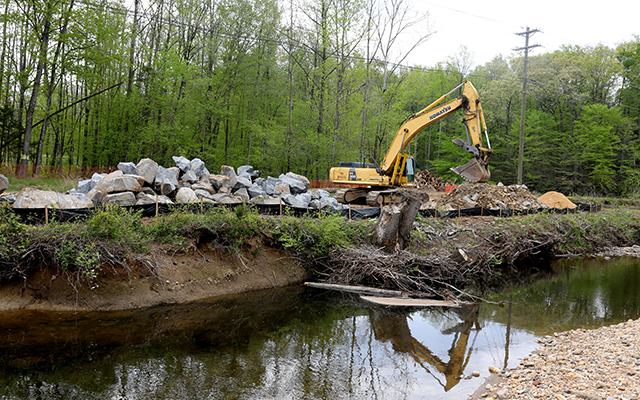Powell’s Creek Stream Restoration Project Underway

Stream restoration projects are major construction sites complete with the trucks and heavy equipment associated with any extensive building, but the benefits of stream restoration spread out after the project is completed.
Stream Restoration Goals
While the primary goals of stream restoration are to protect infrastructure, clean up the watershed and protect property, completed projects create environments for a wide range of water-dwelling macro-invertebrates, fish, birds and mammals. People often take advantage of restored stream sites. "People are able to enjoy walking around the restorations," said Prince William County Environmental Engineer Tom Dombrowski.
New Project Getting Started
The Prince William County Department of Public Works is just beginning a nearly one-mile project along a section of Powell's Creek, just off Cardinal Drive and Merrily Way, behind the Montclair and Four Seasons subdivisions. The two-year project will establish wetlands along the boundaries of Powell's Creek to act as buffers against flooding. "It is actually going to store the water in the wetlands that are on the flood plain and prevent any major flooding downstream from an event."
The current project on Powell's Creek will also improve degraded bank conditions that threaten a sanitary sewer main transmission line.
Federal Requirements
Federal regulations require that localities that are in the Chesapeake Bay Watershed, such as Prince William County, limit the daily amount of sediment, nutrients and other pollution going into their waterways. Deforestation decades ago, and ongoing development, continue to impact streams and make restoration necessary. "If it's out of whack, it's because of how we developed the land around it. Stream restoration is one of the better ways to solve the problem," Dombrowski said.
Project Scope
The project is the largest Public Works has taken on, and entails clearing along the creek, temporarily rerouting Powell's Creek, removing existing sediment, channel relocation to restore the streambed, stream bank reinforcement and replanting with native plants and trees to finish the project and connect Powell's Creek with its wetland system.
All the improvements will create a meandering creek with riffles, where water runs swiftly over rocks to introduce oxygen into the water, along with pools to bring equilibrium to the stream to control sediment. Once established, the new trees and native plants stabilize the stream bank at the same time they provide shade and reduce algal growth. "Even though you're impacting the wetlands temporarily, they're going to be improved and have more hydrology because we're reconnecting to the flood plain," Dombrowski said. "What we're trying to do is restore it to what it was, which is wetland forest. We're changing it to be what it was, the way nature intended it to be."
When Finished
Once fully established, the riparian zone, or areas surrounding the stream, will also take up nutrients before the nutrients can enter Powell's Creek, which runs to the Potomac River, which in turn, flows to the Chesapeake Bay. "By making these changes, we're achieving a goal of preventing pollution from going into the Chesapeake Bay. These goals are multi-faceted."
People look with interest to stream restoration projects. "People look at what we do every day, and they're excited about it when they see what's going to happen," Dombrowski said of stream restoration projects. "A lot of citizens are aware of some of the problems that exist, and they want these corrections made. They see it as a benefit."
Call 703-792-5534 with questions. "Anytime a citizen has questions or issues, we're right there to take the questions on," Dombrowski said.